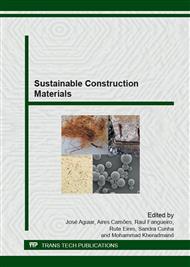[1]
PIGOZZO, J. C. Estudo e aplicações de barras de aço coladas, como conectores em placas mistas de madeira e concreto para tabuleiros de pontes. Thesis (Doctorate) – São Carlos Engineering School, USP - São Carlos, (2004).
DOI: 10.11606/t.18.2004.tde-20122006-103114
Google Scholar
[2]
SEGUNDINHO, P. G. A. Análise teórico-experimental de um tabuleiro misto madeira-concreto composto por vigas circulares. Dissertation (Master's degree) – Faculty of engeneering of Ilha Solteira - UNESP, Ilha Solteira, (2005).
Google Scholar
[3]
Information on https: /www. flickr. com/photos/80651083@N00/141702441.
Google Scholar
[4]
CECCOTTI, A. T. Timber-concrete composite structure. In Timber Engineering. STEP1, Almere, Centrum Hout, E13 (1995) pp.1-12.
Google Scholar
[5]
MATTHIESEN, J. A. Contribuição ao estudo das estruturas mistas: estudo experimental de estruturas mistas de madeira e concreto interligadas por parafusos. Thesis (full professor) – Faculty of engeneering of Ilha Solteira - UNESP, Ilha Solteira, (2001).
DOI: 10.47749/t/unicamp.2001.219077
Google Scholar
[6]
Information on http: /www. anip. com. br/?cont=conteudo&area=32&titulo_pagina=Pro dução.
Google Scholar
[7]
TRIGO, A. P. M. Estudo de lajes com adição de resíduo de pneu. Dissertation (Master's degree) – Faculty of engeneering of Ilha Solteira - UNESP, Ilha Solteira, (2008).
DOI: 10.21475/ajcs.17.11.12.pne907
Google Scholar
[8]
GOODYEAR. Vida Longa Sem Segredos - Cuidados simples no dia a dia prolongam de forma significativa a vida útil dos pneus do seu veículo. Technical orientation report (2010).
Google Scholar
[9]
Information on https: /servicos. ibama. gov. br/index. php/component/content/article/61-servicos/113-relatorio-de-pneumaticos-resolucao-conama-nd-41609.
Google Scholar
[10]
BATAYNEH, M. K.; MARIE, I.; ASI, I. Promoting the use of crumb rubber concrete in developing countries. Waste Management, v. 28, (2008) pp.2171-2176.
DOI: 10.1016/j.wasman.2007.09.035
Google Scholar
[11]
MENEGHINI, E. C. A. Comportamento de argamassas com o emprego de pó de borracha. Dissertation (Master's degree), UNICAMP, Campinas, (2003).
DOI: 10.47749/t/unicamp.2003.281748
Google Scholar
[12]
VASCONCELOS, A. R. B. Análise experimental da durabilidade de concretos de alto desempenho com adição de resíduo de borracha de pneu e cinza da casca de arroz. Dissertation (Master's degree) – Faculty of engeneering of Ilha Solteira - UNESP, Ilha Solteira, (2009).
DOI: 10.1590/s1678-86212010000100009
Google Scholar
[13]
BENAZZOUK, A., Douzane O., Quéneudec M. Transport of fluids in cement-rubber composites. Cement & Concrete Composites, v. 26, (2004) pp.21-29.
DOI: 10.1016/s0958-9465(02)00119-1
Google Scholar
[14]
FAZZAN, J. V. Comportamento estrutural de lajes treliçadas com adição de resíduos de borracha de pneu. Dissertation (Master's degree) – Faculty of engeneering of Ilha Solteira - UNESP, Ilha Solteira (2010).
DOI: 10.21475/ajcs.17.11.12.pne907
Google Scholar
[15]
SANTOS, A. C. Avaliação do comportamento do concreto com adição de borracha obtida a partir da reciclagem de pneus com aplicação em placas pré-moldadas. Dissertação (Master's degree) – Federal Universidade of Alagoas, Maceió – AL, Brazil (2005).
DOI: 10.11606/d.3.2008.tde-15082008-100223
Google Scholar
[16]
TOPÇU, I. B.; AVCULAR, N. Analysis of rubberized concrete as a composite material. Cement Concrete and Research, Elmsford, v. 27, n. 2 (1997), pp.1135-1139.
DOI: 10.1016/s0008-8846(97)00115-4
Google Scholar
[17]
ASSOCIAÇÃO BRASILEIRA DE NORMAS TÉCNICAS - ABNT NBR 7190: Projeto de estruturas de madeira. Rio de Janeiro: ABNT, (1997).
DOI: 10.1590/s1517-707620160004.0098
Google Scholar
[18]
ASSOCIAÇÃO BRASILEIRA DE NORMAS TÉCNICAS - ABNT. NBR 5739: Concreto - ensaio de compressão de corpos-de-prova cilíndricos. Rio de Janeiro: ABNT, (2007).
DOI: 10.11606/d.3.2012.tde-13062013-122430
Google Scholar
[19]
EUROPEAN PRESTANDARD (1993), ENV 1995-1-1, EUROCODE 5 – Design of timber structures – Part 1-1: General rules and rules for buildings, Brussel, Belgium, European Committee for Standardization, December (1993).
Google Scholar


